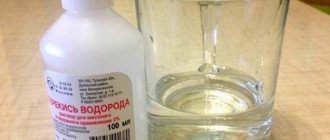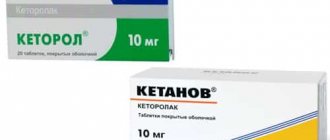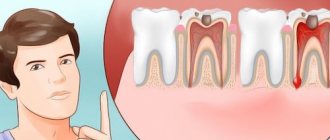Soda, also known as potassium bicarbonate, has many positive properties necessary for oral care. It affects teeth and gums in the following way: removes plaque, reduces inflammation, disinfects the oral cavity, and prevents caries from developing.
When a person regularly uses baking soda as an additive to water when rinsing or cleanses the oral cavity with powder, the result is healthy teeth for a long time. Using baking soda powder, you can even independently remove tartar that has become visible to the naked eye (initially the stone is not visible, it is examined by the dentist under a special lamp and is not yet black in color).
What are the benefits of soda-salt solution for mouth rinsing?
The product is widely used for rinsing during the treatment of diseases of the teeth and gums: caries, gingivitis, periodontitis and periodontal disease. The solution helps out in cases where acute symptoms arise suddenly and you need to alleviate the condition before visiting the dentist. The soda-salt composition perfectly relieves inflammation and redness of the mucous membrane, disinfects, has a calming effect and helps to slightly reduce pain.
Sodium bicarbonate or simply soda is a product that is used to clean dirty surfaces, for example, in the kitchen. But a solution with its addition also helps in the treatment of many dental diseases. In combination with salt and sometimes with iodine, soda gives a pronounced antibacterial effect, strengthens hard and soft tissues, and prevents the further spread of the pathological process. Thus, the effect of the composition can be formulated in several main theses:
- has an antibacterial effect,
- helps stop the pathological process and prevents further destruction of the enamel,
- stops inflammatory processes in the mucous membrane,
- helps to significantly reduce pain and alleviate the condition,
- removes bacterial plaque and tartar.
Soda-saline solution helps in the treatment of many dental diseases.
Soda-saline solution is not suitable for daily use. It is recommended in cases where there are clear signs of pathological processes in the oral cavity. The composition can be used for emergency relief of acute symptoms, and as a maintenance agent - only after agreement with the attending physician.
Baking soda rinse
Baking soda is known for its antifungal effect. A solution with soda gently cleanses the oral cavity and tooth enamel, blocks the development of pathogenic microbes, disinfects the oral cavity, and reduces swelling. In order for teeth rinsing to solve existing dental problems, you must follow the recommendations above and maintain the proportions. Water for rinsing your mouth must be boiled. Use 1 tsp per glass of water. soda The contents of the container must be mixed well, the liquid should be cloudy, whitish, sediment at the bottom is unacceptable. If you are worried about acute toothache, then it is permissible to double the amount of soda.
Soda solution is an excellent oral disinfectant.
Indications for use
It is better to use the composition for rinsing on the recommendation of a specialist - the treating dentist. The main indications for use are listed below:
- heavy plaque, supra- and subgingival deposits, unpleasant odor: the composition effectively fights bacteria in the oral cavity, dissolves hardening deposits and prevents the growth of pathogenic microflora. In addition, the active ingredients have a beneficial effect on the enamel and help strengthen it, and by cleaning surfaces from bacteria and their metabolic products, breath is freshened,
- severe toothache: it is not possible to cure the problem with just rinsing, but it is quite possible to significantly reduce the intensity of acute symptoms. The product will help normalize the condition so you can safely get to the doctor,
- after tooth extraction: preventive rinsing with a soda-salt solution will help fight bacteria, prevent wound infection, help stop bleeding and stimulate healing processes. You just need to rinse carefully so as not to damage the blood clot in the hole,
- diseases of the teeth and gums: rinsing with salt and soda is recommended, among other things, as maintenance therapy during the treatment of caries, gingivitis, periodontitis and periodontal disease, periodontitis and periostitis with purulent processes - according to indications and only in concentrations recommended by a specialist.
Rinsing helps in the treatment of inflammation of the gums and dental plaque.
If there are microtraumas or cuts in the mouth, which may appear, for example, due to braces or incorrectly installed fillings, crowns and dentures, then such a solution will help to effectively disinfect tissues, and its regular use will help their rapid healing.
Why does a tooth hurt under a denture?
A crown is a prosthetic structure in the form of a cap that covers a previously prepared tooth. The cause of tooth pain under the crown in many cases is associated with poor preparation of the unit for prosthetics. Most often, this is a mistake when filling dental canals after pulp removal. The source of pain can be:
- Untreated caries
- the doctor did not remove all the affected tissue, which led to a relapse of the carious process under the crown. - Defects during
canal filling - when filling the canal with composite material, voids are formed, which are quickly populated by pathogenic microflora, which causes inflammation and pain. - Perforation of the canal wall
- when the canal walls are damaged, the filling material begins to extend beyond its boundaries, irritating the periodontium; a complication of the current inflammation can be the formation of granulomas and cysts. - Instrument fragment in the canal
- treatment is carried out with thin instruments, which may break during treatment. If the root is severely curved and difficult to pass, it is often impossible to remove the fragment. It promotes the development of inflammation, even if the canal is sealed hermetically. - Poor quality prosthetics
– the crown does not fit well to the supporting tooth or puts pressure on the gum, causing inflammation. In this case, the teeth under the crown hurt when pressing or biting. - Pulp burn
- occurs if, during the preparation of dental tissues, the doctor allowed overheating of the dentin and the neurovascular bundle hidden under it. The pulp becomes inflamed, reacts painfully to temperature stimuli, and acute pain periodically occurs, turning into aching pain.
If a tooth without a nerve hurts under the crown, this is a sign of periodontal pathology or poor-quality installation of the prosthesis. When a crown is placed on a living tooth that has not undergone depulpation, the painful syndrome, as a rule, indicates pulpitis.
When is it better to avoid rinsing - contraindications
If the recommended dosages are observed, the medicinal solution is completely harmless and safe. But in some pathological conditions and individual intolerance to its components, the use of the product is strictly contraindicated.
So, it is better not to add soda to the composition if a small child is going to rinse the mouth. Under the age of 3-4 years, a child can easily accidentally swallow the concentrated composition, and this is fraught with stomach problems. It is better to soak a cotton swab or a small piece of gauze in the solution, and then apply it to the sore spot for just a few minutes.
Do not use the rinse solution for children under 3-4 years of age.
You should not rinse your mouth with salt and soda if you have a traumatic brain injury, brain disease, or a predisposition to a stroke. In case of thyroid dysfunction, tuberculosis and nephritis, iodine1 should not be added to the main composition. The same applies to women during pregnancy and breastfeeding. Do not rinse too often if they provoke attacks of nausea.
What not to do
There is a lot of “harmful” advice that will only worsen the situation. So, what not to do:
- Do not heat. Under no circumstances apply heating pads, scarves, compresses, warming tampons, etc. to a sore tooth.
- Do not apply tablets. You can often come across advice to put an aspirin tablet on a sore tooth, but this can only cause a chemical burn.
- Do not take antibiotics. In the treatment of certain dental diseases, doctors often use antibiotics. But only a specialist can develop an effective and correct regimen for taking them.
How to prepare a universal soda-salt solution
To prepare the medicinal composition, you need to take a glass of boiled warm water - approximately 27-30 °C, and dilute a teaspoon of soda and salt in it. It is important to stir the bulk ingredients until completely dissolved. After this, you need to rinse your mouth thoroughly for 1-2 minutes, paying special attention to the sore area. By the way, the ingredients are good on their own. So, to relieve acute pain and symptoms of inflammation, you can rinse your mouth with only salt or only soda. In some cases, it is possible to add a few drops of iodine to enhance the effect.
How to use the product correctly
Before rinsing, be sure to brush your teeth. The temperature of the liquid should not exceed 30 °C - ideally it should be slightly warmer than room temperature. Too high a temperature can cause a burn, and cold can increase the pain. You need to use only freshly prepared solution, otherwise it will lose some of its properties. The product should not be swallowed; it must be spat out at the end of the procedure.
“I take out salt and soda only in extreme cases, when someone in the family has an acute inflammation, for example, gumboil. But you can’t use them every day, that’s for sure! A regular pharmaceutical product like Listerine or Colgate is sufficient for daily use. I deliberately take a little less liquid, because if you do it according to the instructions, sometimes it makes your teeth cramp. And a bottle is enough for our family for 2 weeks..."
Ulyasha, from correspondence on the woman.ru forum
If the pain is too severe, it is better to extend the procedure to 5 minutes. In this case, the liquid will have to be renewed every half a minute. It is important to understand that rinsing will help dull severe symptoms, but not cure the disease. Immediately after the condition returns to normal, you should urgently go to the doctor.
Rinsing will help dull severe symptoms, but will not cure the disease.
Rinse your mouth with saline solution
Salt has a pronounced antiseptic effect. It accelerates the healing of wounds and small cuts on the mucous membrane, and also prevents the growth of pathogenic microflora. In combination with soda, it effectively reduces inflammation, reduces the intensity of purulent processes, and helps to slightly reduce pain. The product is recommended for use on gums, mainly in cases of acute inflammatory processes accompanied by the release of pus - periodontitis, periostitis, etc.
The effectiveness of soda solution
Baking soda also relieves inflammation, but also has an antifungal effect. Due to its abrasive properties, the powder perfectly cleanses the enamel of bacterial plaque and other contaminants, helping to restore its natural shine and whiteness. In addition, soda disinfects tissues, reduces swelling and soreness. It is only important to follow the recommended proportions, otherwise you can easily burn the mucous membrane.
Remedy with soda and salt against pain and inflammation
With the development of dental diseases of an infectious nature, accompanied by acute symptoms, a mixture of soda and salt, diluted in boiled water in equal proportions, helps well. The product relieves toothache and prevents the further spread of the pathological process. The composition can be used as an emergency aid or as part of maintenance therapy after consultation with a specialist.
Soda-salt composition with added iodine
If you add a few drops of iodine to salt and soda, you can significantly enhance the effect of the drug. Iodine actively fights pathogenic microflora and prevents the proliferation of pathogens. All three components in combination with each other provide a pronounced analgesic effect and help reduce bleeding and swelling of soft tissues. You just need to be careful with iodine - you need to strictly adhere to the dosage and take into account possible contraindications.
Iodine actively fights pathogenic microflora
Recommendations for preparing the product for different occasions
The solution is very easy to prepare, and the ingredients for it can be found in any home. Just keep in mind that the liquid needs to be prepared anew each time, and to dilute the components you should use warm boiled water or room temperature. Depending on the problem, recommendations for using the composition may be different - let's look at them in more detail.
When a toothache takes you by surprise
To relieve acute pain in teeth, it is recommended to dilute a teaspoon of salt in a glass of warm water. You can rinse your mouth every half hour until the intensity of the symptom subsides. You can add a teaspoon of soda to the main composition - then the effect will be more pronounced and come faster. Many also advise adding a couple of drops of iodine. On how to properly rinse a sore tooth, experts give the following recommendations:
- Before rinsing, you need to brush your teeth with a brush and toothpaste,
- the solution should be warm or at room temperature - if it is too cold or hot, the pain will only intensify,
- It is better to keep the liquid from the side of the causative tooth, focusing on treating the diseased area,
- There is no need to rinse your mouth with water after the procedure.
Rinsing is also used to relieve acute pain in the teeth.
As mentioned above, upon completion of the procedure, the liquid must be spat out. Each time the composition must be prepared anew, otherwise its effectiveness will significantly decrease.
If there are signs of acute inflammation in the soft tissues
To treat inflamed gums, the composition is recommended in the same proportions - about 200 ml of warm boiled water and a teaspoon of salt and soda. In this case, you can add a couple of drops of sage essential oil or a drop of iodine. Regular rinsing will help relieve swelling and soreness, reduce redness of the gums and strengthen the mucous tissue.
The composition can only be used in courses, and not on an ongoing basis, otherwise the effect may be reversed. The product will speed up the healing process if the mucous membrane hurts after tooth extraction. Only in this case, you shouldn’t rinse too intensely - you can simply hold the liquid behind your cheek on the side of the causative tooth.
While brushing your teeth for prevention
Sometimes salt and soda are recommended to be added to daily dental and oral care products. So, for example, in the composition of toothpaste, these ingredients enhance its abrasive and whitening properties. It is enough to squeeze a small amount of paste onto the brush, then take a little of the mixed powder and brush your teeth thoroughly for a minute.
Baking soda is also used when brushing teeth
Try not to touch your gums, and after completing the procedure, rinse your mouth with plain water. The mixture can be used in this way for a limited period of time. Otherwise, you can seriously injure the enamel, and this is fraught with the development of hyperesthesia and other unpleasant consequences.
Why is regular salt replaced with sea salt?
Some dentists advise taking baths and rinsing sore teeth with a solution of baking soda and sea salt. The fact is that this product contains an increased amount of iodine, which has an antimicrobial effect. In addition, this salt helps strengthen tooth enamel.
To prepare a healing solution for tooth pain, you need to take 1 tsp. soda and sea salt and dilute them with 250 ml of warm water. To strengthen the enamel of teeth, it is enough to rinse sensitive teeth with a mixture containing 1 small spoon of bulk product and half a glass of water.
To weaken the effect of pathogenic microbes living in the oral cavity and remove heavy odor, you can rinse your mouth with a solution of soda and hydrogen peroxide. To make the medicine, take 250 ml of heated water and add 3 tbsp. l. 3% peroxide and 1 tbsp. l. sodium bicarbonate without a slide. The mixture is thoroughly stirred and used for therapeutic rinsing of the mouth. It is not recommended to take the drug internally or use it for any other therapeutic purposes.
Despite the beneficial properties of salt, iodine and soda, medicinal mixtures based on them can only be used as first aid or auxiliary treatment. If acute pain or inflammation occurs, you should contact your dentist as soon as possible and begin therapy aimed at eliminating the cause of the disease.
Can it be used during pregnancy?
Regarding the best way to rinse your mouth during pregnancy, you should definitely consult your dentist. It is not prohibited to use a soda-salt solution during this period, however, all precautions must be taken and if a pronounced gag reflex appears, stop the procedure immediately.
You also need to take into account that sometimes the combination of salt, soda and iodine gives an allergic reaction. Solutions with added iodine are generally not recommended during pregnancy. Do not exceed the dosage prescribed by the doctor so as not to provoke complications.
During pregnancy, you should be wary of any treatment methods.
Features of use in childhood
The composition can be given to children only from the age of 5. It is important that the child can already independently control the procedure, otherwise the baby may accidentally swallow the composition, and this is fraught with undesirable consequences for his stomach and digestive system. In addition, the components can leave burns on the mucous membrane.
For older children, the product is prepared according to the same principle, but in a lower concentration - half a teaspoon per glass of warm water. It is better to avoid iodine altogether - the effect of salt and soda is quite enough to relieve acute symptoms and disinfect tissues.
What are the pros and cons?
The main advantages are the availability of ingredients, ease of preparation, effectiveness and safety. Among the key advantages, experts highlight the following points:
- quickly relieves pain and inflammation,
- removes plaque and cleanses enamel, freshens breath,
- stimulates the healing of microtraumas and wounds on the mucous membrane,
- inhibits the formation of dental plaque,
- strengthens hard and soft tissues - the composition is useful for both teeth and gums,
- Easy to prepare from simple and affordable ingredients - a good budget option.
The disadvantages include unpleasant sensations due to enamel hyperesthesia, as well as a specific taste, which in rare cases causes attacks of nausea. In addition, the composition only relieves symptoms, but does not treat the disease itself, so its use is good before or after visiting a doctor, and then only as maintenance therapy.
- Borovsky E.V. Therapeutic dentistry, 2006.
What happens if you ignore warning signs?
If inflammation is not eliminated, over time the pathological process will destroy bone tissue, which will lead to loss of teeth. In addition, pus accumulated in soft tissues can enter the intermuscular space or subcutaneous area. This can lead to melting of nearby tissues, requiring the intervention of an oral and maxillofacial surgeon.
It is difficult to treat a prosthetic tooth; this will require unfilling the canals, conducting anti-inflammatory therapy, and filling the canals again. If the inflammation has affected the root apex, surgical intervention will be required - resection of the apex along with the granuloma or cyst.
The doctor decides how to relieve pain under the crown individually in each clinical situation, based on the cause, stage, and extent of inflammation. Sometimes the situation goes so far that the only effective treatment method is the removal of a tooth followed by prosthetics.











